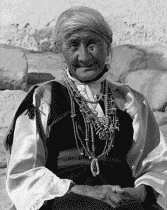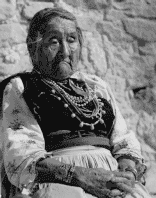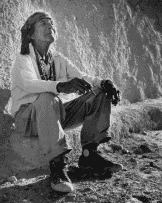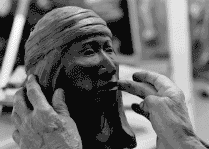 Rosita Rosita |  Juana Juana | |||||
 Platero Platero |
 Jeff Jeff | |||||
 Alan Houser's
Hands Alan Houser's
Hands | ||||||
| ||||||
 Rosita Rosita |  Juana Juana | |||||
 Platero Platero |
 Jeff Jeff | |||||
 Alan Houser's
Hands Alan Houser's
Hands | ||||||
| ||||||
by
Harrison Fletcher
There are many beginnings, but this is as good a place as any to start: About 40 years ago, Lee was delivering groceries from his dad's trading post when he noticed an old man sunning himself beside an adobe wall.
"Hey, Jeff, how about a picture?"
"No," the old man said, scowling. "No picture."
The old man was Jeff Sousea, the popular caretaker of Laguna Mission. he had a reputation for taking an occasional sample of the sacremental wine and for telling tourists about lost gold mines.
Lee had tried to photograph him before, but he refused to remove his sunglasses.
"Aw, come on, Jeff."
"No," he scowled. "No picture."
By that time, Lee had earned a reputation of his own. He was the stocky kid with the camera, the one hounding the old folks. Sometimes they said yes. Sometimes they said no. Sometimes, Lee sweetened the deal.
"Here's a cigar, Jeff. how about a picture?"
The old man paused.
"OK. One picture."
And so, Lee Marmon knelt in the dust of Laguna plaza and photographed an 85 year old man wearing a traditional headband, traditional jewelry and a pair of Keds high-top sneakers.
He called the portrait, "White Man's Moccasins."
You might not guess on first glance, but the owner of the used bookshop at Laguna Pueblo, the man with the thick black mustache, baseball cap and faded blue jeans, once shook hands with presidents. He met an astronaut, and Wonder Woman too.
But you won't find him sunning at the Bahamas or putting at the golf course. You'll find Lee Marmon in a shopping center about an hour west of Albuquerque, sitting behind a cluttered desk, playing with his cat at the Blue-Eyed Indian Bookstore.
Lee is the blue-eyed Indian, one-quarter Laguna, born and raised on the pueblo. His grandfather, Ohio-born Robert Marmon, was the first white governor of Laguna and among the scouts who tracked Geronimo. His daughter, author Leslie Marmon Silko, wrote the acclaimed books Ceremony and Almanac of the Dead.
At age 69, he's quite accomplished himself, having been a teacher, a postmaster and a photographer whose work has appeared in galleries, books and magazines nationwide. He and his assistant, Robin Webb, were recently commissioned to photograph Colorado's Ute Indians. The 16 portraits will be permanently displayed at the new Denver airport.
These days, when he's not shooting weddings, portraits or publicity photos, he's at the bookshop, sorting through used novels. "This is the only bookstore between Albuquerque and Gallup," he says. "Probably the only one on a reservation. Truckers and tourists stop by all the time. You know, there's nothing like cheap entertainment." In the shop, you'll find everything from the 1995 "Women of the Navajo" calendar, pocket readers of Kant and summaries of President Clinton's health-care proposal.
You'll also find a modest collection of Lee's work: stark black and white photos of people such as Bruce Riley, former Laguna war chief; Santana, a renowned Santo Domingo potter; and old Jeff, who became his signature photograph.
When he shot the portraits, Lee never expected they would propel a career. He never thought they would leave the walls of his home. Back then, Lee says, no one knew things would change so fast.
When Lee was a boy, there were no telephones in Laguna. There weren't too many cars either. In fact, if eight travellers rolled by on Route 66, it was a busy day.
During the day, they worked in the fields, on the farms or for the Santa Fe railroad. At night, they listened to radio programs and dreamed of the big fiesta, a weeklong celebration attracting visitors from as far away as Arizona, some of whom arrived in covered wagons.
At one time or another, during fiesta or not, everyone from vagabonds to royalty walked through the doors of the Marmon Trading Post, which stocked shoes, lumber, soda pop, and postage stamps.
It was run by Lee's father, from the choice location on the main drag next to the railroad station. Among the notable customers who walked through its doors were Arthur MacArthur, the famous general's dad, and early Southwest photographers Edward Curtis, Adam Vroman and Willian Henry Jackson.
At the time, Lee didn't pay too much attention to celebrities, or cameras. He was busy hiking through the scrub-covered hills around the pueblo or target pracitising with friends, once severing the utilities while shooting at birds.
He also delivered groceries in a chopped down Model A pickup held together with bailing wire, bubble gum and prayer. From the seat of that open-air jalopy, he'd rip through the backroads of the pueblo, memorizing the houses and the people who lived there.
At age 10, he entered the ranks of professional photographers when he received a $2 check for shooting a truck wreck for an insurance company.
It had been his dad's idea. he was the one who heard about the wreck, handed the boy a Kodak postcard camera and said, go to it. When he thinks about it now, Lee says that the car wreck was a prophecy for what would come.
Like most kids his age, he dismissed such omens and eventually attended the University of New Mexico, where he planned to study geology. But after a few uninspiring semesters, he dropped out during World War II, joined the Army and served three years in Alaska. There, amid a landscape so utterly different from the New Mexico desert, Lee made a promise.
"I was on a ship and we were approaching the port and it was just beautiful," he says. "The water was like glass, there was snow on the mountains. I told myself I would get a camera if it was the last thing I did."
When Lee returned home, he bought a Speed Graphic camera and photographed everything in sight; penitente crosses, a bloody horse atop a crumpled Chevy, a pesky buzzard he brought down with a single pistol shot. Once, his photos of a burned down San José River bridge even made the morning newspaper in Albuquerque.
"I just shot anything that happened," he says, "Most of it was too bloody to print." Then, on the advice of his dad, Lee began seeking out village elders. "Take their pictures," his father said. "Soon they'll all be gone."
He photographed old-timers plastering walls, old-timers husking corn, old-timers being old-timers. He captured the scowling Platero, whose finger was bitten off by a horse, the grizzled Mateas, who modeling fee was two silver dollars and a pound of coffee, and José Teofilo, a hunter who tracked deer into his 80s.
In 1966 he left New Mexico for the swimming pools and golf courses of Palm Springs, CA, as the official photographer for the Bob Hope Desert Classic. In a blue binder in his bookshop, Lee keeps a record of those swinging years. there's page after page of bathing beauties, Hollywood royalty and vacationing Republican power brokers. During those years, he photographed Richard Nixon, Raquel Welch and Clint Eastwood, to name a few.
But, despite a substantial salary and all the nice things that went with it, Lee kept returning to Laguna, to those old faces and the portraits that have become the core of his work.
Always he came home.
Today Lee Marmon is surrounded by memories.
He lives with his wife, Kathryn, and son, Leland, in the old Santa Fe Railroad building. He works in a darkroom converted from a Depression era washroom. He spends some afternoons walking by the adobe where he was born and the boarded up trading post where he once worked.
He still photographs the Laguna people, but has turned to weddings and conventions to supplement his income.
His father was right, he says. There was something special about the elders. They had an integrity and a spirit that you don't see much anymore. His biggest regret: he didn't take more portraits.
Still, tradition survives.
Every so often, a Laguna old-timer brings a grandchild to Lee's bookshop and stands before the portraits, explaining how life used to be.
For the price of a silver dollar, a pound of coffee, or even a cigar, Lee managed to preserve some of the old ways and the old faces. In his own way, he brought his people a measure of notoriety and even immortality.
Out there somewhere, old Jeff is smiling.
Return to the Index of Artists